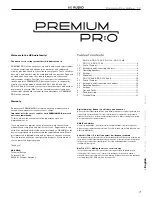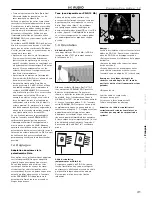
Premium Pr:o Active 1.7
10
2 PR:O 18 Sub A,
PR:O 210 Sub A
2.1 Control Features
1
2
3
4
5
6
7
8
9
1 Out L / Out R (Line Out Mid / High)
These two electronically balanced XLR inputs
serve to connect PREMIUM PR:O satellites
(pin 1= ground, 2= +, 3= -).
2 Input L / Input R
These two electronically balanced XLR / 1/4"
combi inputs accept signals from mixing
consoles (pin 1= ground, 2= +, 3= -).
3 Through L / Through R
These two parallel outputs patch incoming
line signals through, for example, to other
PREMIUM PR:O active speakers or monitors
(pin 1= ground, 2= +, 3= -).
4 Gain Bass
This knob adjusts the input level (center
position = 0 dBV).
The 12 o’clock position is the ideal starting
point when operating the subwoofer in
combination with a PREMIUM PR:O active
cabinet. Then you can simply twist the knob
to the left or right to cut and boost bass
frequencies. If you connect a PREMIUM PR:O
satellite, first set the Gain knob to the center
detent and then adjust the level to suit the
given sound reinforcement situation.
5 X-Over-Bass
The active crossover can serve to vary the top
cutoff frequency of the subwoofer with a range
of 75 to 150 Hz. The best cutoff frequency
for the given application depends on the
surroundings and satellite, so you will have to
experiment.
Note: If you set the cutoff to a frequency
higher than 110 Hz, the subwoofer will
render mostly the lower frequencies of
signals generated by bass guitars, kick
drums, and low-end keyboard sounds. If you
set the cutoff to a frequency higher than
110 Hz, the subwoofer will also render the
lower frequencies of voices and other sound
sources.
6 Phase
The Phase switch changes the subwoofer’s
phase position to match it to the connected
satellite’s phase position (0° – 180°). Set the
switch to 0° when operating the PR:O 18
Sub A in combination with a PREMIUM PR:O
active cabinet. The PR:O 210 Sub A‘s phase
has to be reversed 180° to ensure it is in phase
with PREMIUM PR:O mid-/high-range units.
You may have to invert the phase for
combinations with other enclosures. If you are
unsure, simply try the 180° setting. If the bass
response changes and the signal sounds weak
and washed out, the phase setting is incorrect.
7 Limiter Status LED
This dichromic LED indicates the signal level
and limiter status. Green means the signal level
is okay; red means the limiter has engaged and
is responding to high-volume signal peaks.
CAUTION! This is not a clip LED. It’s okay
if it lights up red briefly every now and
then; this merely indicates the RMS Limiter
is operating. If the signal LED remains
constantly in the red at signal peaks, check
the source signal’s input level and back off
the speaker’s Gain knob. A status LED that
lights up red continuously indicates there is
a fault in the speaker system.
8 Power Switch
This is the PREMIUM PR:O powered cabinet’s
on/off button. The signal LED lights up green
to indicate the cab is powered up.
Note: The Power button is embedded to
prevent unintentional actuation. Set to
Power On, the button sits almost flush with
the connector panel. This ensures it is not
engaged accidentally, yet remains readily
accessible.
9 Mains Input
Use the factory-included mains cord to
connect this socket to a wall outlet.
Note: All PREMIUM PR:O active speakers are
equipped with V-Lock mains sockets. If you
use a VOLEX locking mains cord or another
optionally available brand with the same
design, you can fix the mains cord in place
to prevent accidental disconnection.
2.2 Setting Up and Con-
necting the Cabinet
Connect cords routed from your mixer
(monitor out, line out, or a similar output)
to the balanced Input sockets using a cord
equipped with standard XLR microphone
connectors. Then connect the active satellites
to the XLR outputs labeled X-Over Out. Use
the two Through ports to feed the fullrange
signal to other enclosures. Make sure the
XLR connectors’ terminals are configured as
follows: 1= ground, 2= +, 3= -. If only one
Input signal is available, select “Input L”. To
get full power out of the system, connect
“Through L” with “Input R” via XLR cords.
2.3 Operating Speakers
• First make sure the powered cabinet is off.
CAUTION! Connect the cabinet to the mains
supply only after you are certain the local
mains voltage matches the voltage specified
on the rear panel. If you connect the system
to the wrong mains voltage, you may destroy
the electronic components of the PREMIUM
PR:O active cabinet.
• Back the Gain knobs all the way off, turning
them counterclockwise as far as they will go.
Ensure you first switch on all other connected
components, for example, a connected
mixing console as well as all signal sources
patched into it, such as keyboards, instrument
amps, effects and so forth. Always connect
PREMIUM PR:O active cabinets to Line Out
Mid/High, and always switch them on last;
that is, after you switch on all other connected
components. When you powering down, first
turn the Gain knobs to the far left and switch
active cabinets off first, before switching off
any connected devices.











































